Thermodynamic Performance Assessment of a Novel Micro-CCHP System Based on a Low Temperature PEMFC Power Unit and a Half-Effect Li/Br Absorption Chiller
Abstract
:1. Introduction
2. System Description
3. System Modeling
3.1. PEM Fuel Cell
- steady-state conditions;
- pressure and temperature constant into the fuel cell;
- reactants and products treated as perfect gases;
- product water at the cathode side is assumed to be liquid;
- fully hydration is assumed at the cathode/membrane interface;
- equilibrium between the water vapor and liquid is always assumed;
- humidifying water temperature is the same of the cooling water temperature;
- convective effects are negligible because of small Reynolds numbers.
- Anode reaction:
- Cathode reaction:
- Overall reaction:
3.2. Half-Effect Absorption Chiller
- steady-state conditions
- the refrigerant at outlet state of the condenser is saturated liquid
- the refrigerant at outlet state of the evaporator is saturated vapor
- the temperature of high and low absorber is equal
- the temperature of high and low generator is equal
- the pressure losses in pipelines and all heat exchanger are negligible
- the expanding process in the throttling valves is isenthalpic
- the reference environmental state is water at T0 of 25 °C and P0 of 1 atm
3.3. Models Validation
4. Results and Discussion
4.1. Trigeneration System Operating Field
- −
- “area ABC” (CCHP mode) in which a portion of waste heat recovered is used to satisfy the heating demand and the rest is supplied to absorption chiller for cooling. The electric, thermal and cooling power range are 1.92–6.03 kWe, 0.33–1.97 kWt and 0.33–1.97 kWc, respectively.
- −
- “area DEF” (CCP mode) in which all the waste heat recovered is used entirely as thermal input in the absorption chiller to meet the cooling request only. The electric and cooling power range are 1.92–6.03 kWe and 0.48–2.82 kWc, respectively.
- −
- “area GHI” (CHP mode) in which all the waste heat recovered is used entirely to cover the heating request only. The electric and thermal power range are 1.92–6.03 kWe and 1.13–6.55 kWt, respectively.
4.2. Trigeneration System Performance
5. Conclusions
Conflicts of Interest
References
- Wu, D.W.; Wang, R.Z. Combined cooling, heating and power: A review. Prog. Energy Combust. Sci. 2006, 32, 459–495. [Google Scholar] [CrossRef]
- Mingxi, L.; Yang, S.; Fang, F. Combined cooling, heating and power systems: A survey. Renew. Sustain. Energy Rev. 2014, 35, 1–22. [Google Scholar]
- Cho, H.; Smith, A.D.; Mago, P. Combined cooling, heating and power: A review of performance improvement and optimization. Appl. Energy 2014, 136, 168–185. [Google Scholar] [CrossRef]
- Jradi, M.; Riffat, S. Tri-generation systems: Energy policies, prime movers, cooling technologies, configurations and operation strategies. Renew. Sustain. Energy Rev. 2014, 32, 396–415. [Google Scholar] [CrossRef]
- Rong, A.; Su, Y. Polygeneration systems in buildings: A survey on optimization approaches. Energy Build. 2017, 151, 439–454. [Google Scholar] [CrossRef]
- Sibilio, S.; Rosato, A.; Ciampi, G.; Scorpio, M.; Akisawa, A. Building-integrated trigeneration system: Energy, environmental and economic dynamic performance assessment for Italian residential applications. Renew. Sustain. Energy Rev. 2017, 62, 920–933. [Google Scholar] [CrossRef]
- Abdollahi, G.; Sayyaadi, H. Application of the multi-objective optimization and risk analysis for the sizing of a residential small-scale CCHP system. Energy Build. 2013, 60, 330–344. [Google Scholar] [CrossRef]
- Jannelli, E.; Minutillo, M.; Cozzolino, R.; Falcucci, G. Thermodynamic performance assessment of a small size CCHP (combined cooling heating and power) system with numerical models. Energy 2014, 65, 240–249. [Google Scholar] [CrossRef]
- Li, M.; Mu, H.; Li, N.; Ma, B. Optimal design and operation strategy for integrated evaluation of CCHP (combined cooling heating and power) system. Energy 2016, 99, 202–220. [Google Scholar] [CrossRef]
- Gu, W.; Lu, S.; Wu, Z.; Zhang, X.; Wang, J. Residential CCHP microgrid with load aggregator: Operation mode, pricing strategy, and optimal dispatch. Appl. Energy 2017, 205, 173–186. [Google Scholar] [CrossRef]
- Lozano, M.A.; Carvalho, M.; Serra, L.M. Operational strategy and marginal costs in simple trigeneration systems. Energy 2009, 34, 2001–2008. [Google Scholar] [CrossRef]
- Pei, H.; Liu, Z.; Zhang, H.; Yu, Y.; Tu, Z.; Wan, Z.; Liu, W. In situ measurement of temperature distribution in proton exchange membrane fuel cell I a hydrogen-air stack. J. Power Sources 2013, 227, 72–79. [Google Scholar] [CrossRef]
- Chen, X.; Li, W.; Gong, G.; Wan, Z.; Tu, Z. Parametric analysis and optimization of PEMFC system for maximum power and efficiency using MOEA/D. Appl. Therm. Eng. 2017, 121, 400–409. [Google Scholar] [CrossRef]
- Tu, Z.; Zhang, H.; Luo, Z.; Liu, J.; Wan, Z.; Pan, M. Evaluation of 5 kW proton exchange membrane fuel cell stack operated at 95 °C under ambient pressure. J. Power Sources 2013, 222, 277–281. [Google Scholar] [CrossRef]
- Schicktanz, M.D.; Wapler, J.; Henning, H.M. Primary energy and economic analysis of combined heating, cooling and power systems. Energy 2011, 36, 575–585. [Google Scholar] [CrossRef]
- Elmer, T.; Worall, M.; Wu, S.; Riffat, S.B. Fuel cell technology for domestic built environment applications: State of-the-art review. Renew. Sustain. Energy Rev. 2015, 42, 913–931. [Google Scholar] [CrossRef]
- Barelli, L.; Bidini, G.; Gallorini, F.; Ottaviano, A. An energetic exergetic comparison between PEMFC and SOFC-based micro-CHP systems. Int. J. Hydrogen Energy 2011, 36, 3206–3214. [Google Scholar] [CrossRef]
- Radulescu, M.; Lottin, O.; Feidt, M.; Lombard, C.; Le Noc, D.; Le Doze, S. Experimental results with a natural gas cogeneration system using a polymer exchange membrane fuel cell. J. Power Source 2006, 159, 1142–1146. [Google Scholar] [CrossRef]
- Yilanci, A.; Dincer, I.; Ozturk, H. Performance analysis of a PEM fuel cell unit in a solar–hydrogen system. Int. J. Hydrogen Energy 2008, 33, 7538–7552. [Google Scholar] [CrossRef]
- Jannelli, E.; Minutillo, M.; Perna, A. Analyzing microcogeneration systems based on LT-PEMFC and HT-PEMFC by energy balances. Appl. Energy 2013, 108, 82–91. [Google Scholar] [CrossRef]
- Campanari, S.; Valenti, G.; Macchi, E.; Lozza, G.; Ravidà, N. Development of a micro cogeneration laboratory and testing of a natural gas CHP unit based on PEM fuel cells. Appl. Therm. Eng. 2014, 71, 714–720. [Google Scholar] [CrossRef]
- Hwang, J.; Wang, P.; Kuo, J. Simulation and experiment of a cogeneration system based on proton exchange membrane fuel cell. Fuel Cells 2012, 12, 326–334. [Google Scholar] [CrossRef]
- Hwang, J.; Lin, C.; Kuo, J. Performance analysis of fuel cell thermoelectric cogeneration system with methanol steam reformer. Int. J. Hydrogen Energy 2014, 39, 14448–14459. [Google Scholar] [CrossRef]
- Chen, X.; Gong, G.; Wan, Z.; Luo, L.; Wan, J. Performance analysis of 5 kW PEMFC-based residential micro-CCHP with absorption chiller. Int. J. Hydrogen Energy 2015, 40, 10647–10657. [Google Scholar] [CrossRef]
- Chang, H.; Wan, Z.; Zheng, Y.; Chen, X.; Shu, S.; Tu, Z.; Chan, S.H.; Chen, R.; Wang, X. Energy- and exergy-based working fluid selection and performance analysis of a high-temperature PEMFC-based micro combined cooling heating and power system. Appl. Energy 2017, 204, 446–458. [Google Scholar] [CrossRef]
- Chahartaghi, M.; Kharkeshi, B.A. Performance analysis of a combined cooling, heating and power system with PEM fuel cell as a prime mover. Appl. Therm. Eng. 2018, 128, 805–817. [Google Scholar] [CrossRef]
- Chen, X.; Gong, G.; Wanb, Z.; Zhang, C.; Tu, Z. Performance study of a dual power source residential CCHP system based on PEMFC and PTSC. Energy Convers. Manag. 2016, 119, 163–176. [Google Scholar] [CrossRef]
- Herold, K.E.; Radermacher, R.; Klein, S.A. Absorption Chillers and Heat Pumps; CRC Press: Boca Raton, FL, USA, 2016. [Google Scholar]
- Minutillo, M.; Perna, A. Behaviour modelling of a PEMFC operating on diluted hydrogen feed. Int. J. Energy Res. 2008, 32, 1297–1308. [Google Scholar] [CrossRef]
- Cozzolino, R.; Cicconardi, S.P.; Galloni, E.; Minutillo, M.; Perna, A. Theoretical and experimental investigations on thermal management of a PEMFC stack. Int. J. Hydrogen Energy 2011, 36, 8030–8037. [Google Scholar] [CrossRef]
- Amphlett, J.C.; Baumert, R.M.; Mann, R.F.; Peppley, B.A.; Roberge, P.R.; Harris, T.J. Performance Modelling of Ballard Mark IV Solid Polymer Electrolyte Fuel Cell. J. Electrochem. Soc. 1995, 142, 1–8. [Google Scholar] [CrossRef]
- Mann, R.F.; Amphlett, J.C.; Hooper, M.A.I.; Jensen, H.M.; Peppley, B.A.; Roberge, P.R. Development and application of a generalised steady-state electrochemical model for a PEM fuel cell. J. Power Sources 2000, 86, 173–180. [Google Scholar] [CrossRef]
- Fowler, M.W.; Mann, R.F.; Amphlett, J.C.; Peppley, B.A.; Roberge, P.R. Incorporation of voltage degradation into a generalised steady-state electrochemical model for a PEM fuel cell. J. Power Sources 2002, 106, 274–283. [Google Scholar] [CrossRef]
- Jannelli, E.; Minutillo, M.; Galloni, E. Performance of a PEM fuel cell system fuelled with hydrogen generated by a fuel processor. J. Fuel Cell Sci. Technol. 2007, 4, 435–440. [Google Scholar] [CrossRef]
- Ferguson, A.; Ugursal, V.I. Fuel cell modelling for building cogeneration applications. J. Power Sources 2004, 137, 30–42. [Google Scholar] [CrossRef]
- Tribioli, L.; Cozzolino, R.; Chiappini, D.; Iora, P. Energy management of a plug-in fuel cell/battery hybrid vehicle with on-board fuel processing. Appl. Energy 2016, 184, 140–154. [Google Scholar] [CrossRef]
- Kreith, F. Principles of Heat Transfer; Brooks/Cole: Boston, MA, USA, 2001. [Google Scholar]
- Somers, C.; Mortazavi, A.; Hwang, Y.; Radermacher, R.; Rodgers, P.; Al-Hashimi, S. Modeling water/lithium bromide absorption chillers in ASPEN Plus. Appl. Energy 2011, 88, 4197–4205. [Google Scholar] [CrossRef]
- Maryami, R.; Dehghan, A.A. An exergy based comparative study between LiBr/water absorption refrigeration systems from half effect to triple effect. Appl. Therm. Eng. 2017, 124, 103–123. [Google Scholar] [CrossRef]
- Chicco, G.; Mancarella, P. Trigeneration primary energy saving evaluation for energy planning and policy development. Energy Policy 2007, 35, 6132–6144. [Google Scholar] [CrossRef]
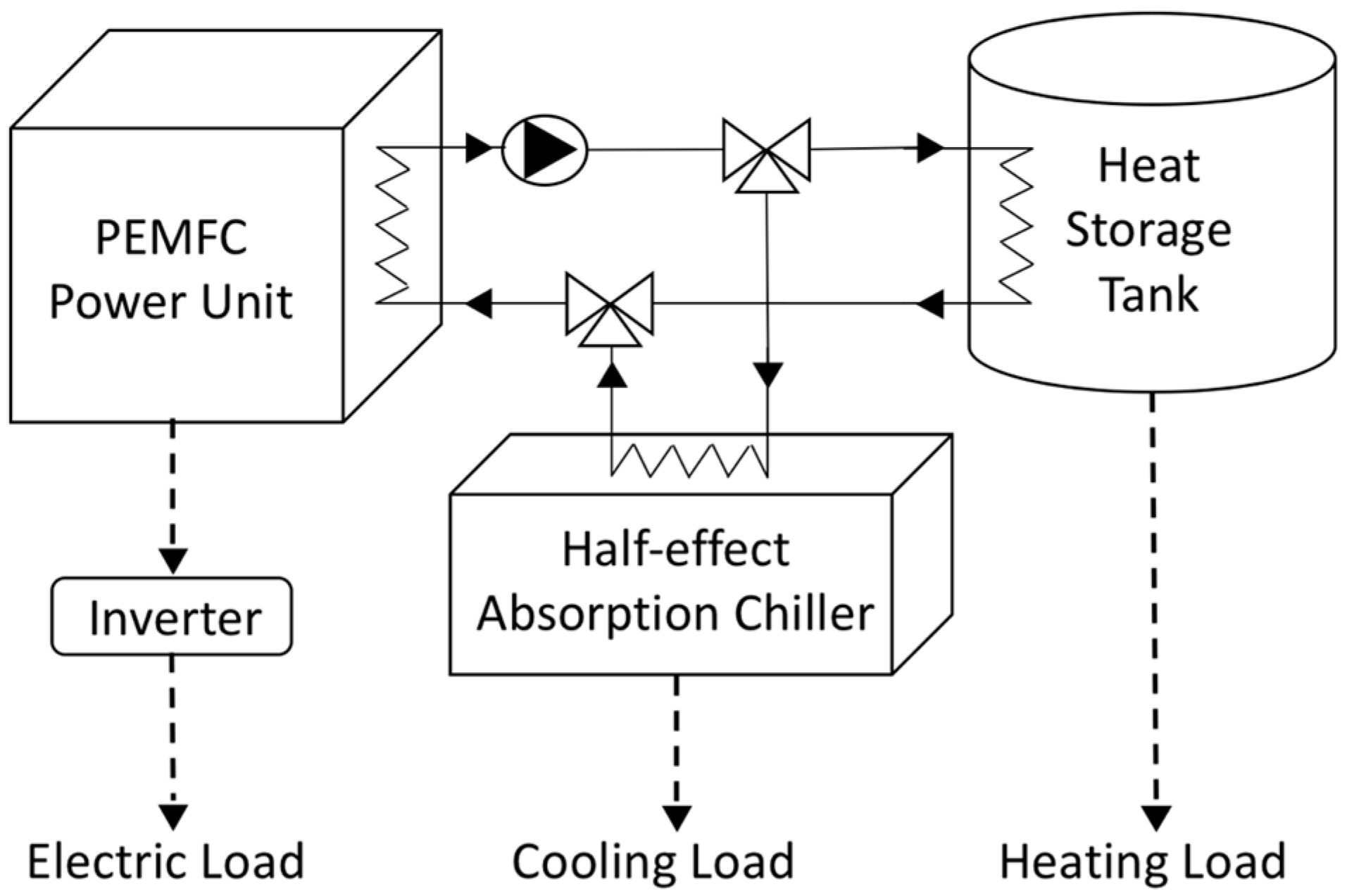
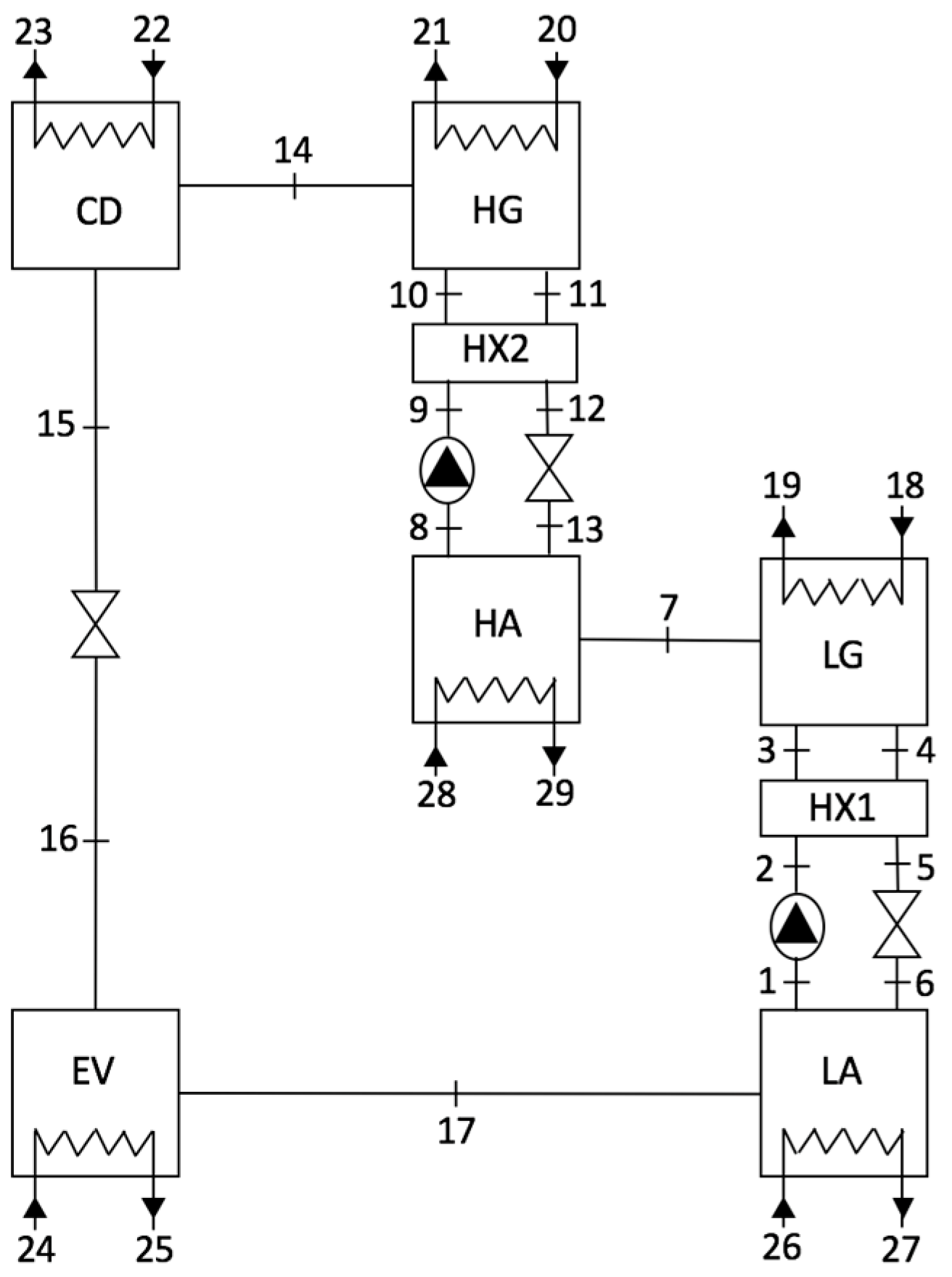

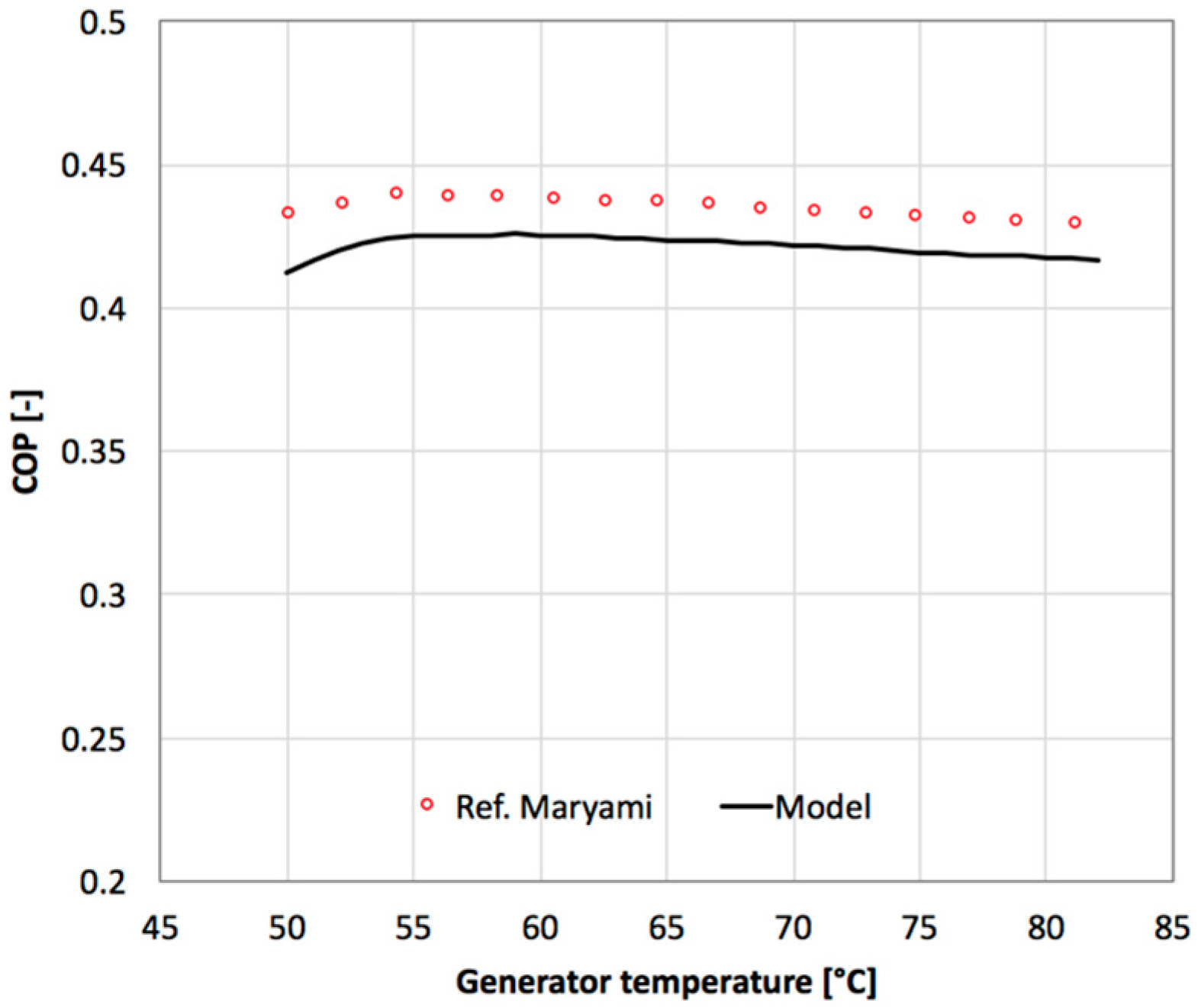
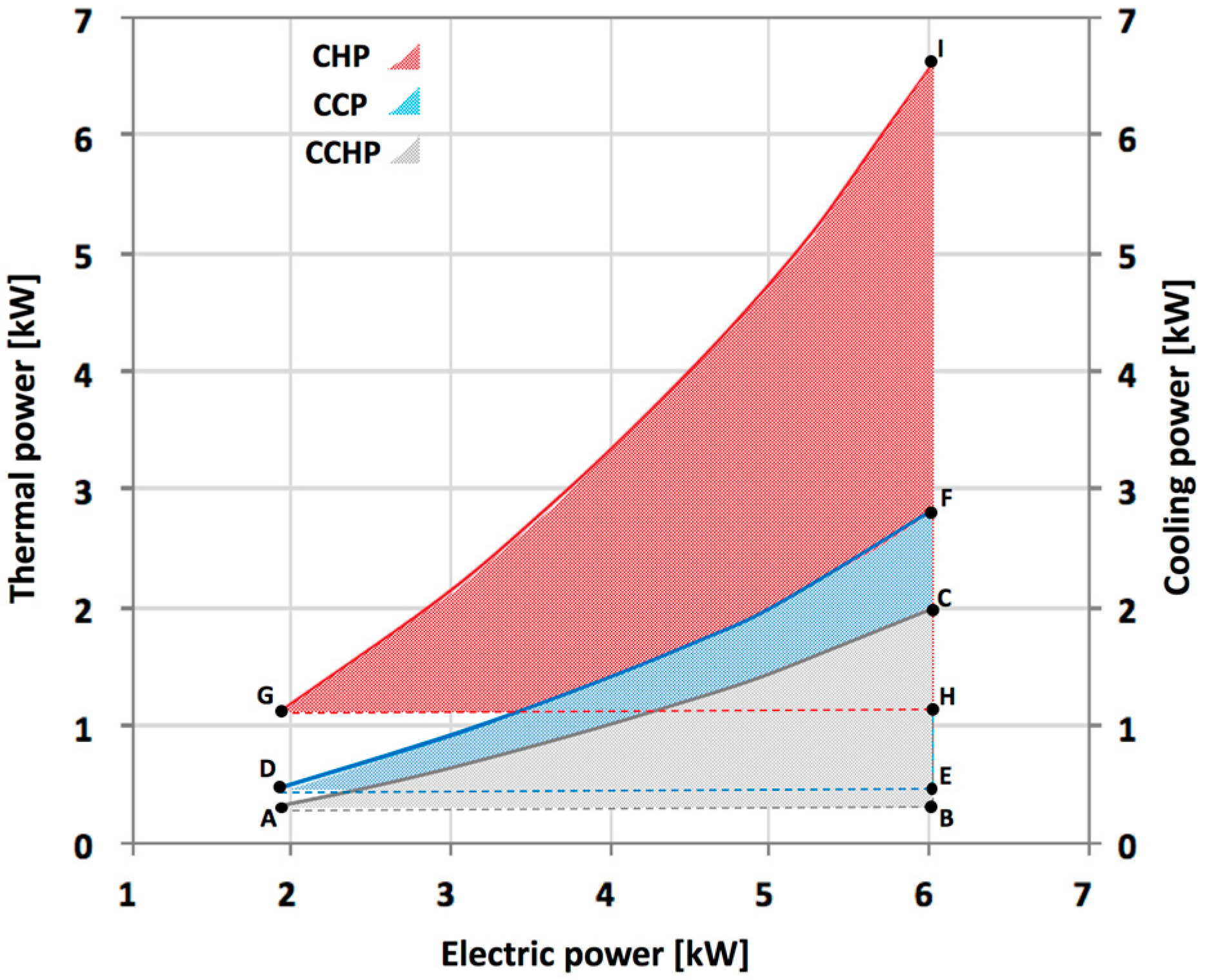
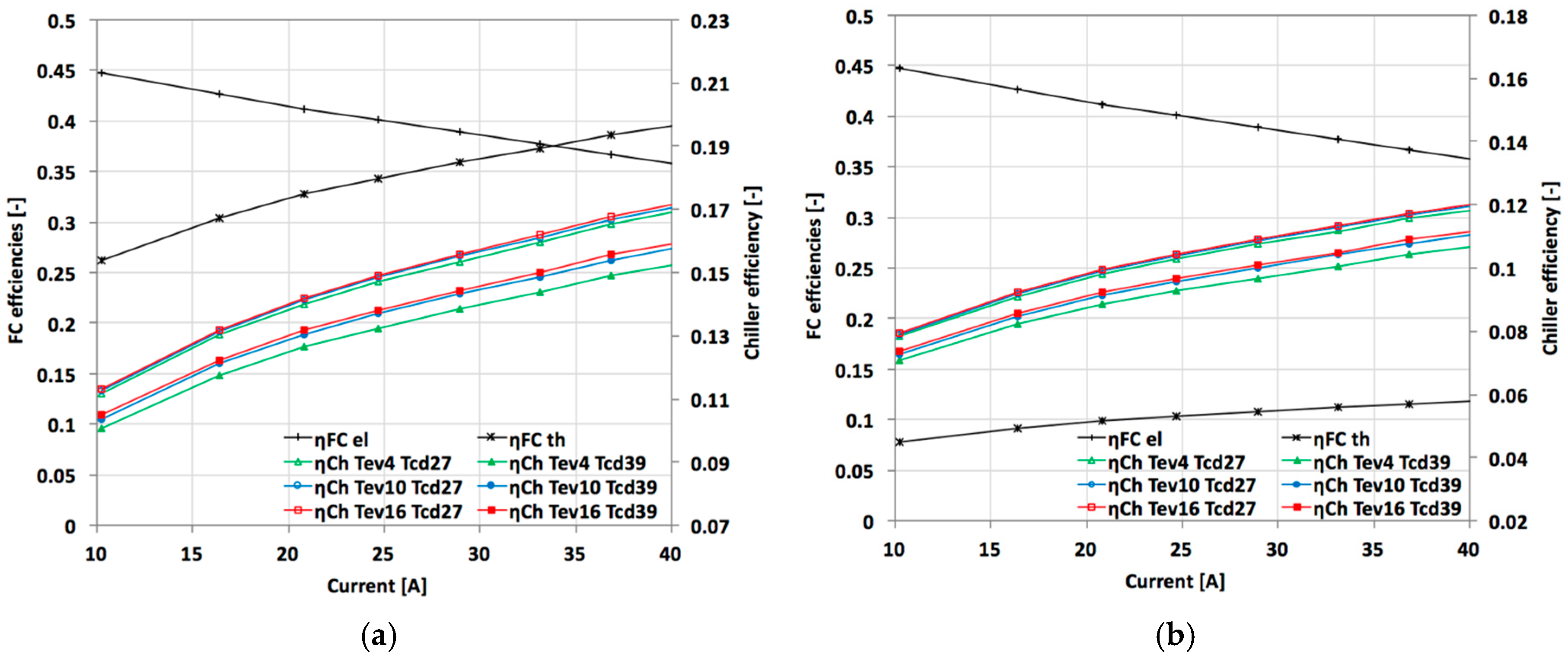

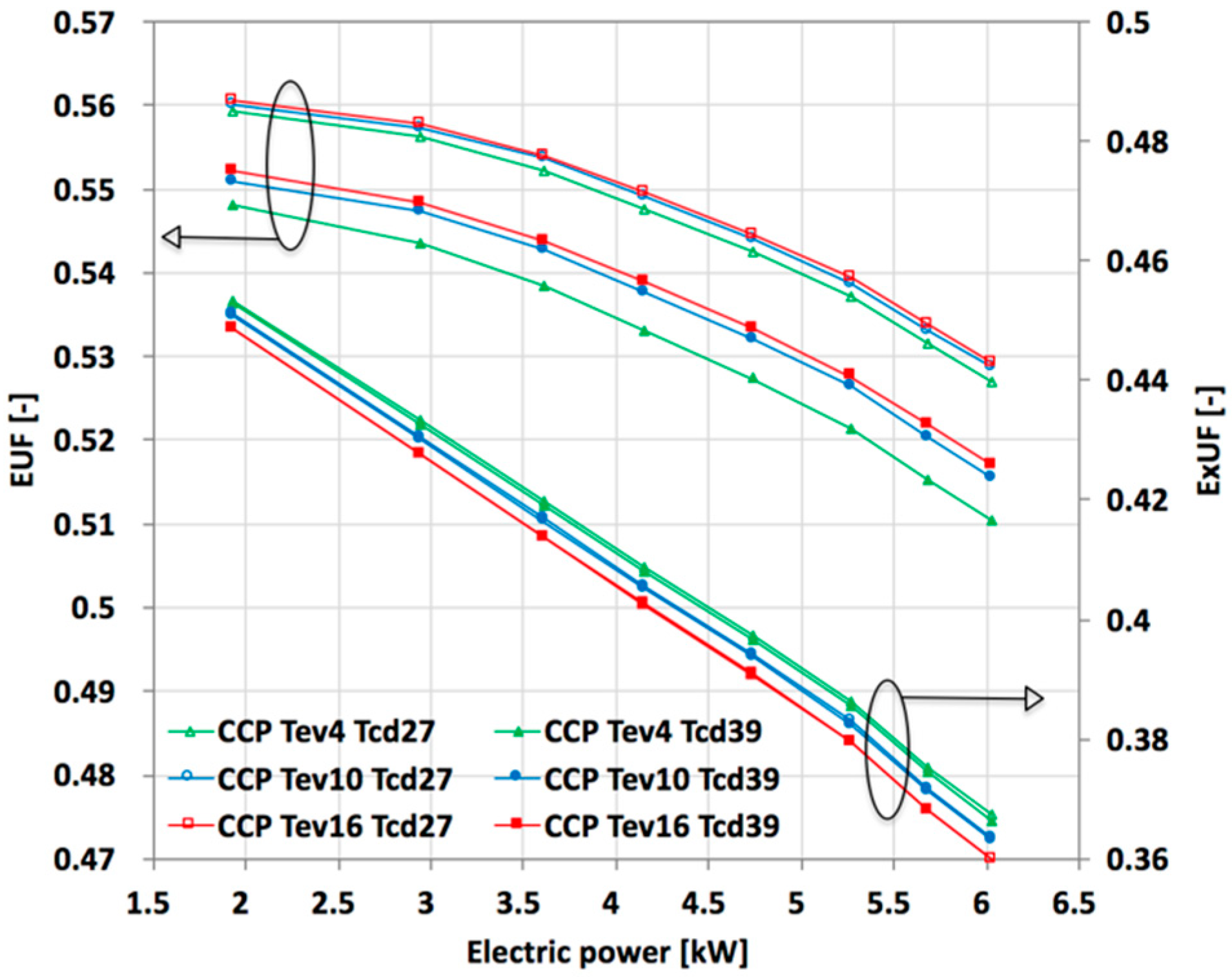
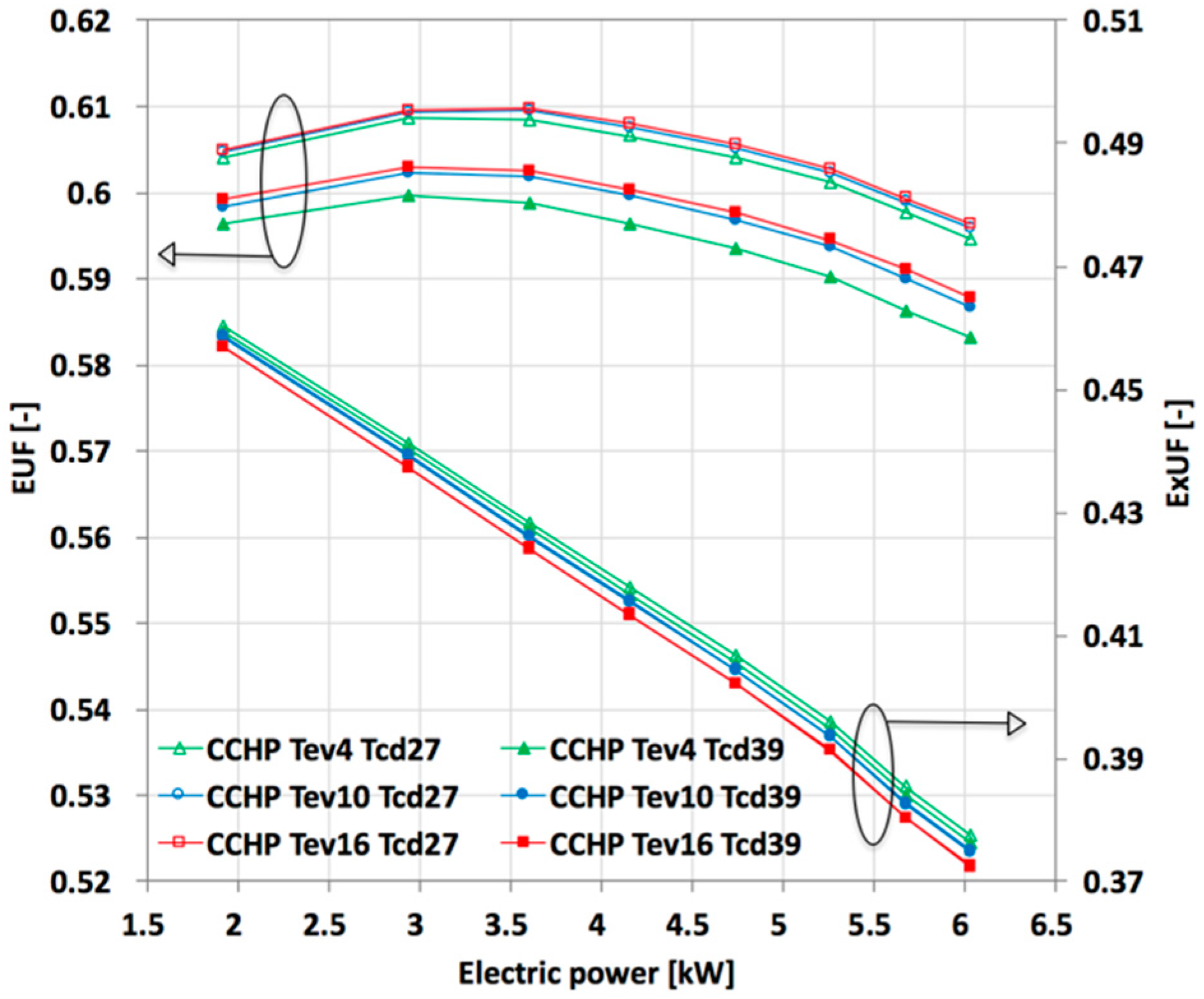
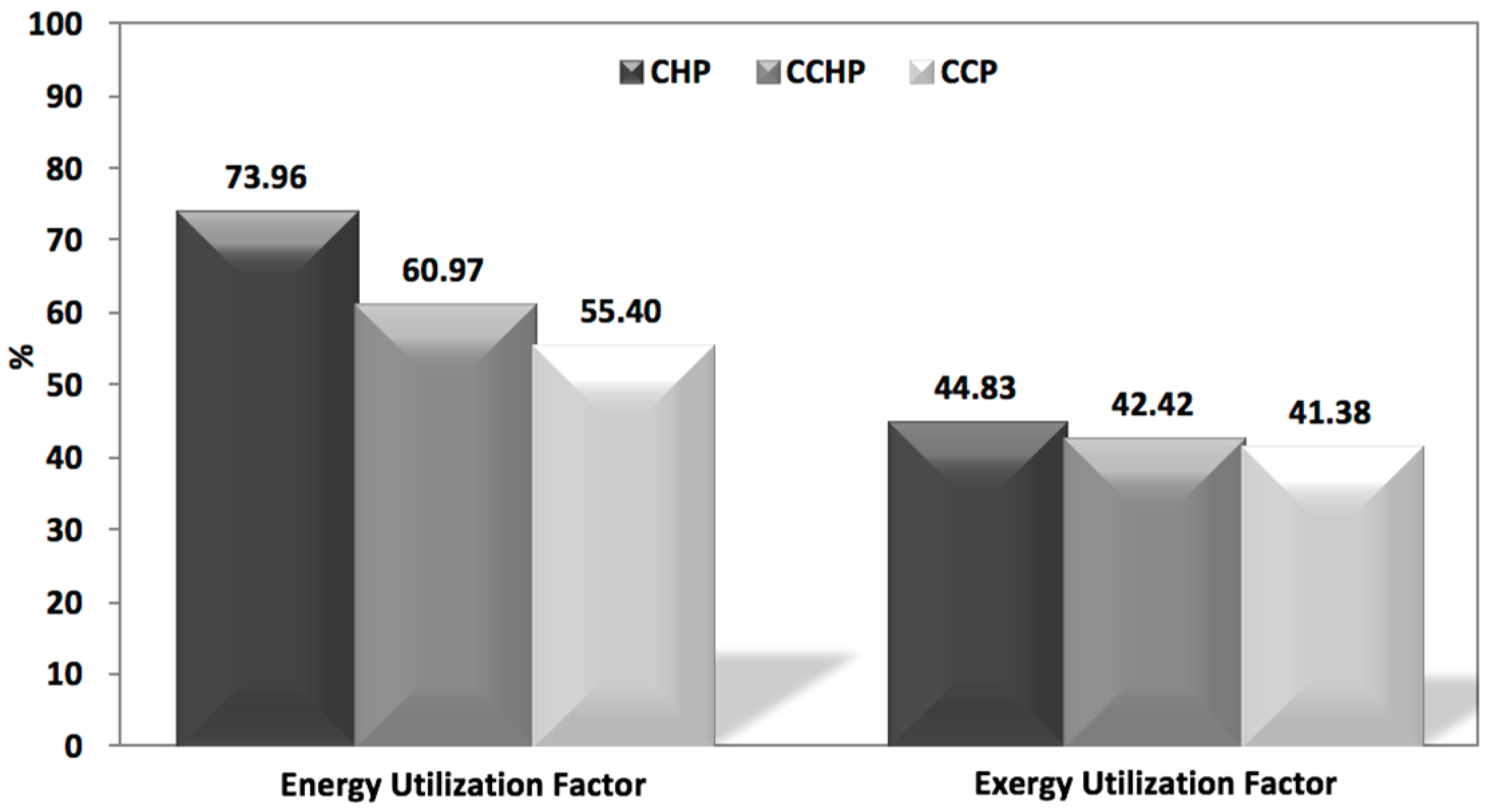
| Reaction | Forward | Backward |
|---|---|---|
| H2 + 2M ↔ 2(M − H) | K1 | K2 |
| 2(M − H) → 2H+ + 2e− + 2M | K3 | - |
| CO + M ↔ (M − CO) | K4 | K5 |
| (M − CO) + H2O → CO2 + 2H+ + 2e− + M | K6 | - |
| CO2 + 2M − H → M − CO + H2O + M | K7 | - |
| Component | Mass and Energy Balance and Governing Equations. |
|---|---|
| Low Generator (LG) | |
| High Generator (HG) | |
| Low Absorber (LA) | |
| High absorber (HA) | |
| Condenser (CD) | |
| Evaporator (EV) | |
| Heat exchanger (HX1) | ; |
| Heat exchanger (HX2) | ; |
| Coefficient of performance (COP) |
| Model input [30] | Characteristic and Operating Parameter | Unit | Value |
| A | cm2 | 200 | |
| λ | - | 23 | |
| l | cm | 0.178 | |
| T | °C | 67 | |
| Pa | atm | 1 | |
| Pc | atm | 1 | |
| RHa | % | 100 | |
| RHc | % | 100 | |
| UF | - | 0.8 | |
| UAir | - | 0.5 | |
| Fuel | mol % | 75% H2 20% CO2 3% N2 2% CH4 | |
| h | kW/m2 K | 6 × 10−3 | |
| σ | kW/m2 | 5.67 × 10−11 | |
| ε | - | 0.97 | |
| AStack | m2 | 0.15 | |
| Troom | °C | 25 | |
| Tw,in | °C | 57 | |
| Tw,out | °C | 67 | |
| Electrochemical model output (40 A) | Output | Unit | Value |
| Vcell | V | 0.655 | |
| Vohmic | V | 0.0189 | |
| Vact,a | V | 0.0181 | |
| Vact,c | V | 0.468 | |
| VStack | V | 30.13 | |
| Pel | kW | 1.206 | |
| Pch,in | kW | 3.412 | |
| Pch,out | kW | 0.672 | |
| Thermal model output (40 A) | kW | 1.31 | |
| kW | −0.085 | ||
| kW | 0.216 | ||
| kW | 0.091 | ||
| kg/s | 0.031 |
| Model input | Operating Parameter | Unit | Value | ||
| Low pressure | kPa kPa kPa °C °C °C °C | 1.228 2.255 5.033 58.2 33 33 10 | |||
| Medium pressure | |||||
| High pressure | |||||
| THG = TLG | |||||
| THA = TLA | |||||
| TCD | |||||
| TEV | |||||
| LiBr conc. (state 1) | % | 51.4 | |||
| LiBr conc. (state 8) | % | 43.1 | |||
| % | 70 | ||||
| kW | 300 | ||||
| Model output | Output | Unit | Model Value | Reference Value [39] | Discrepancy % |
| kW | 300 | 300 | - | ||
| kW | 705.04 | 685.1 | 2.82 | ||
| kW | 311.42 | 308.8 | 0.84 | ||
| kW | 693.55 | 676.3 | 2.48 | ||
| COP | - | 0.425 | 0.437 | 2.74 | |
| State Point | Mass Flow (kg/s) | T (°C) | P (kPa) | LiBr (%) | H2O (%) | Vapor Frac. (–) |
|---|---|---|---|---|---|---|
| 1 | 0.009813 | 33.48 | 1.228 | 51.39 | - | 0 |
| 2 | 0.009813 | 33.48 | 2.255 | 51.39 | - | 0 |
| 3 | 0.009813 | 42.02 | 2.255 | 51.39 | - | 0 |
| 4 | 0.008626 | 56.0 | 2.255 | 58.47 | - | 0 |
| 5 | 0.008626 | 45.55 | 2.255 | 58.47 | - | 0 |
| 6 | 0.008626 | 44.89 | 1.228 | 58.47 | - | 0.00066 |
| 7 | 0.001878 | 56 | 2.255 | - | 100 | 1 |
| 8 | 0.009668 | 33.72 | 2.255 | 42.9 | - | 0 |
| 9 | 0.009668 | 33.72 | 5.083 | 42.9 | - | 0 |
| 10 | 0.009668 | 42.05 | 5.083 | 42.9 | - | 0 |
| 11 | 0.008480 | 56 | 5.083 | 49.02 | - | 0 |
| 12 | 0.008480 | 45.76 | 5.083 | 49.02 | - | 0 |
| 13 | 0.008480 | 41.01 | 2.255 | 49.02 | - | 0 |
| 14 | 0.001187 | 56 | 5.083 | - | 100 | 1 |
| 15 | 0.001187 | 33.09 | 5.083 | - | 100 | 0 |
| 16 | 0.001187 | 9.91 | 1.228 | - | 100 | 0.039 |
| 17 | 0.001187 | 9.91 | 1.228 | - | 100 | 1 |
| 18 | 0.080260 | 67 | 101.325 | - | 100 | 0 |
| 19 | 0.080260 | 57 | 101.325 | - | 100 | 0 |
| 20 | 0.078602 | 67 | 101.325 | - | 100 | 0 |
| 21 | 0.078602 | 57 | 101.325 | - | 100 | 0 |
| 22 | 0.139957 | 25 | 101.325 | - | 100 | 0 |
| 23 | 0.139957 | 30 | 101.325 | - | 100 | 0 |
| 24 | 0.135069 | 18 | 101.325 | - | 100 | 0 |
| 25 | 0.135069 | 13 | 101.325 | - | 100 | 0 |
| 26 | 0.155518 | 25 | 101.325 | - | 100 | 0 |
| 27 | 0.155518 | 30 | 101.325 | - | 100 | 0 |
| 28 | 0.157056 | 25 | 101.325 | - | 100 | 0 |
| 29 | 0.157056 | 30 | 101.325 | - | 100 | 0 |
| State Point | Mass Flow (kg/s) | T (°C) | P (kPa) | LiBr (%) | H2O (%) | Vapor Frac. (–) |
|---|---|---|---|---|---|---|
| 1 | 0.006853 | 33.48 | 1.228 | 51.39 | - | 0 |
| 2 | 0.006853 | 33.48 | 2.255 | 51.39 | - | 0 |
| 3 | 0.006853 | 42.02 | 2.255 | 51.39 | - | 0 |
| 4 | 0.006024 | 56.0 | 2.255 | 58.47 | - | 0 |
| 5 | 0.006024 | 45.55 | 2.255 | 58.47 | - | 0 |
| 6 | 0.006024 | 44.89 | 1.228 | 58.47 | - | 0.00066 |
| 7 | 0.000829 | 56 | 2.255 | - | 100 | 1 |
| 8 | 0.006758 | 33.72 | 2.255 | 42.9 | - | 0 |
| 9 | 0.006758 | 33.72 | 5.083 | 42.9 | - | 0 |
| 10 | 0.006758 | 42.05 | 5.083 | 42.9 | - | 0 |
| 11 | 0.005928 | 56 | 5.083 | 49.02 | - | 0 |
| 12 | 0.005928 | 45.76 | 5.083 | 49.02 | - | 0 |
| 13 | 0.005928 | 41.01 | 2.255 | 49.02 | - | 0 |
| 14 | 0.000830 | 56 | 5.083 | - | 100 | 1 |
| 15 | 0.000830 | 33.09 | 5.083 | - | 100 | 0 |
| 16 | 0.000830 | 9.91 | 1.228 | - | 100 | 0.039 |
| 17 | 0.000830 | 9.91 | 1.228 | - | 100 | 1 |
| 18 | 0.056053 | 67 | 101.325 | - | 100 | 0 |
| 19 | 0.056053 | 57 | 101.325 | - | 100 | 0 |
| 20 | 0.054907 | 67 | 101.325 | - | 100 | 0 |
| 21 | 0.054907 | 57 | 101.325 | - | 100 | 0 |
| 22 | 0.097834 | 25 | 101.325 | - | 100 | 0 |
| 23 | 0.097834 | 30 | 101.325 | - | 100 | 0 |
| 24 | 0.094420 | 18 | 101.325 | - | 100 | 0 |
| 25 | 0.094420 | 13 | 101.325 | - | 100 | 0 |
| 26 | 0.108710 | 25 | 101.325 | - | 100 | 0 |
| 27 | 0.108710 | 30 | 101.325 | - | 100 | 0 |
| 28 | 0.109749 | 25 | 101.325 | - | 100 | 0 |
| 29 | 0.109749 | 30 | 101.325 | - | 100 | 0 |
| (°C) | 61.97 | - | - |
| CHP | 0.11 | - | - |
| CCP | - | - | - |
| CCHP | 0.11 | - | - |
| (°C) | 9.49 | 15.49 | 21.49 |
| CHP | - | - | - |
| CCP | 0.064 | 0.042 | 0.020 |
| CCHP | 0.064 | 0.042 | 0.020 |
| Points | A | B | C |
|---|---|---|---|
| (kW) | 4.30 | 16.84 | 16.84 |
| (kW) | 1.92 | 6.03 | 6.03 |
| (kW) | 0.33 | 0.33 | 1.97 |
| (kW) | 0.33 | 0.33 | 1.97 |
| TPES | 0.19 | −0.07 | 0.09 |
© 2018 by the author. Licensee MDPI, Basel, Switzerland. This article is an open access article distributed under the terms and conditions of the Creative Commons Attribution (CC BY) license (http://creativecommons.org/licenses/by/4.0/).
Share and Cite
Cozzolino, R. Thermodynamic Performance Assessment of a Novel Micro-CCHP System Based on a Low Temperature PEMFC Power Unit and a Half-Effect Li/Br Absorption Chiller. Energies 2018, 11, 315. https://doi.org/10.3390/en11020315
Cozzolino R. Thermodynamic Performance Assessment of a Novel Micro-CCHP System Based on a Low Temperature PEMFC Power Unit and a Half-Effect Li/Br Absorption Chiller. Energies. 2018; 11(2):315. https://doi.org/10.3390/en11020315
Chicago/Turabian StyleCozzolino, Raffaello. 2018. "Thermodynamic Performance Assessment of a Novel Micro-CCHP System Based on a Low Temperature PEMFC Power Unit and a Half-Effect Li/Br Absorption Chiller" Energies 11, no. 2: 315. https://doi.org/10.3390/en11020315





